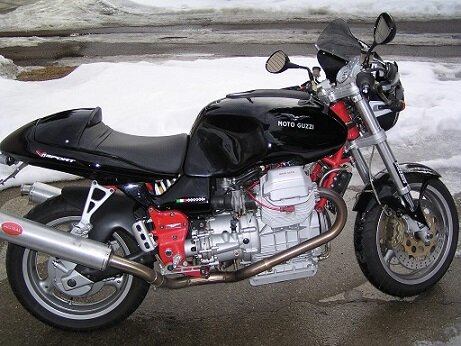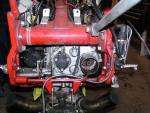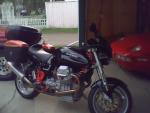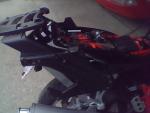
BrianG
-
Posts
743 -
Joined
-
Last visited
Content Type
Profiles
Forums
Events
Gallery
Community Map
Posts posted by BrianG
-
-
Do cage applications use grease on the transmission input shaft splines?
-
I hope summer get here quick..... the cabin fever seems to be more likely fatal this year than in previous seaasons....

-

I've a 2004 Lemans and when it is warmed up the clutch does not completley disengage. This is most noted when stopped and you are tying to find neutral or shift into first gear. I replaced the clutch master cylinder and used a hand vaccum bleeder tool with no results. Anyone have some ideas? If I must change the slave cylinder it appears that the engine must be moved forward one to two inches. Comments? Thanks in advance.
mfeeney
I can think of no mechanical issue other that than an air embolism that would cause this.
It can be a bit tricky to bleed the master cylinder. I recommend retrograde bleeding. That is, force brake fluid UP from the slave cylinder bleed nipple.
-
They are known to get weepy.......
I had my tranny out and apart when I did mine because I had a seep at the case junctions.
It looks like you could hook it out and pound in a new one from the back insitu.....
-
Just wondering if anyone has done this on the bike with the rear wheel/dirve shaft, ect. removed. Possible or not? Or is removal of the tranny unit needed. Any information would be appreciated other wise it will be learn as I go. As of yet I have not had to do alot to my 02' Naked Sport but this has reached the point where I cant ignore it anymore.
Thanks
I did mine last winter with the transmission out, but it looks like it's doable insitu. 0
It would be a heck of a lot easier if you pull the swing-arm.
-
That is what I thought, but I was told in another thread that it must be the bean counters.
I find it hard to believe the single piece brass fitting costs more than the three part brass and plastic piece. But if they got a deal from a Fiat supplier, that could explain it.
I was concerned that the sensor could only endure so much cylinder head temperature, but I was assured that it is not a problem.
But why did they put cooling fins on the brass piece?
Or why doesn't the sensor plug directly into the head?
It does suggest that some piece of this puzzle may still be missing.....
-
The change from brass sensor holder to plastic mid-production was a very strong tell-tale that it was Aprilia's bean-counters influencing production decisions, not the engineers.
Don't you read Dilbert? It's not a comic strip, it's a documentary on the life of a corporate engineer. Scott Adams used to work for Pac Bell. Just like in the strip, the company accountants are demons from Heck.

Yes indeed, your observation of a mid-production change is strong evidence of bean-counter interference.... did you notice the characteristic smell?
No, I don't read Dilbert, dealing with patients daily is humorous enough.......
-
A temp sensor measures how hot the luvin' is

But seriously, on the right cylinder head there is a sensor screwed into a fragile plastic adapter which is screwed into the cylinder head.
There is no metal to metal contact between cylinder head and sensor, and the ECU is known to respond slowly to the engine's warming up, so people have theorized that you should put conductive goo into where you screw the sensor to conduct the heat to the sensor, providing the ECU with a higher temperature reading. For some reason, what goo you use is a contentious issue. I have used silver conductive grease, but it was poopoo'd, for lack of conductivity, so don't you dare use it!!!
An alternative solution is to buy mapping software and tweak the temperature compensation map.
But that is more expensive than a little goo, and you might end up selling your pciii on ebay, so don't let that happen.
Is there any chance that the MG engineers actually designed the head-temp sensor system purposefully and contemplated the data delivery in the context of the sensor mounting method?
I don't want to attribute any more intelligence to the design engineers than is appripriate, but really.........
-
I'm with Ratchet on this. Set the sags to determine proper springing, then lift the rear with the "preload" adjustment up to 2 cm (1 cm of shock extension). Get the narrower rear tire as well.
"Preload" is a misnomer and only sets ride height until the system tops out, so there is easily 1 cm of adjustability in the shock for most riders.
If you want to get radical you can chop 1" out of the spine and steepen the steering head angle 1 degree, and end up with a real motorcycle.....

-
I have mounted the Givi N141 WingRack to my 2000 V-11 Sport.
To that I mount a pair of E21 top opening panniers and a E52 top case in whatever combination I require....
It's a tad cold to get pictures (-40 C/F tonite) but I'll get some pics of the home-bodged mounting system on here ASAP. It's simple and it's stable and it doesn't look too much like crap!

-
................................ you can remove the final drive and rear half of the driveshaft by removing the centre grease point (to release the suction) ................................
Very good point!

Took me a while to figure this one out!!

-
Brian, as discussed "way back when" when you did your "Rube Goldberg" ropes and pulleys torque measurements, and I used a ball-point pen retractor button to detect actual changes in resistance to turn at the bar-ends at different torques on the adjuster nut, I b'lieve your assessment is still right on target. With ~20 ft.-lb on the adjuster nut and the front wheel off the floor, my fork will freely flop against its stops with next to no resistance felt at the bars. My experience has been that when torqued up another ~5 ft.-lb., it just starts to have a perceptible effect on resistance at the bar ends. I reckon that ~20 ft.-lb is about right, and that +/- ~5ft.-lb ought to be an acceptable operating tolerance.
Good info!
If anyone's inclined to be squeamish about putting this much torque on a headset, imagine the combination of axial and radial loads at the bearings through the wedge effect of the races when the bike is fully loaded, underway, and it hits a square-edged bump full-wallop, that brings the fork to its full compression stroke, and then consider that those forces must spike up by at least two or three orders of magnitude or more over the forces when the bike is at rest with the wheel off the ground -- with no ill effects (by design), and well within operating tolerances.
+1 - some preload is critical to achieve appropriate assembly rigidity.
-
This article compares tapered and ball in a Honda ST1100
http://home.insightbb.com/~mmartin36/Taper.htm
It was a little unclear but I read it to indicate 3.3 to 4.4 lb torque for tapered and 20 foot pounds for ball.
I usualy use about 1 to 3 foot pounds, but I do it without ropes, weights or torque wrench, so accuracy is not present.
I think Brian makes a good point and 4 foot pounds may be more appropriate.
And Pete made a good point or two about the problems associated with measuring torque.
When you think about it, steering-head stem nut torque values are worse than valueless unless this value is attached to a particular motorcycle. The value at question is "bearing preload". Stem-nut torque translates to bearing preload by the multiplication factor of the steering stem thread pitch. I have seen much variation in steering stem thread pitches.
I think the upshot of this discussion is to go one of two ways for tapered roller bearing equipped steering heads:
FACT = Tapered roller bearing equipped steering heads REQUIRE some preload.
Near enough estimate = torque the steering stem nut enough to slightly restrict the turning of the triple clamp.
Measured estimate = torque the steering stem nut enough to create 4 lb ft torque resistance to steering head movement.
Note........... both are estimates of the required values.

-
It has been my understanding that ball bearing require preload to create the necessary elipitical small contact patches of the balls in the groove of the race(s). This preload is dependent upon bearing size. If the preload is applied excessively, Bearing Fatigue Life will be short and will increase raceway noise as well. Bearing starting and running torque will also be high. If the applied preload is insufficient, fretting corrosion can occur. This happens as a result of vibration causing the balls to resonate and abrade on the raceways. Therefore, obtaining the correct preload is very important.
It has been my understanding that roller bearings must avoid axial loads, and thus require zero preload.
It has been my understanding that tapered roller bearings are a design compromise between the two previous types require light preload. Only enough to create a mild elastic compressive distortion, to positively locate the rollers in their races. This creates a very rigid bearing that resists displacement, and runs very true.
I have generally used an old Honda preload method to accomplish "enough" tapered bearing preload. The exercise is to load the steering stem nut enough to result in a 4 lb. ft. resistance to steering stem turning. I do this by hanging a 4 lb weight on a cord, over a pulley, attached to a lever running across the fork leg clamps on the lower triple clamp, 1' from the center of the steering stem. This is simple and effective for a double tapered roller bearing steering stem assembly.
You want some fun..... figure out how to preload an old VFR steering head, with a tapered roller lower and a ball bearing upper!! <_>
-
So, the $99 Innovate gauge might not have been good enough?
If you had an LM-1 you probably could have narrowed that quite a bit more.

But the XD-1/16 looks cool

(just kidding....go with whatever floats your boat. If I had more money I would get a nice gauge, too.)
Now if I could just get the LM-1 to work after two years...The second sensor is on order and it better work darnit!!!!
I got the XD-1 before the DB or G-series gages were available. As well, the XD-1 allows me to feed/read data from the LMA-3 and TC-4 without peripherals.
I have the LM-1 for temporary tuning installations, used with a tail-pipe sniffer.
-

My XD-1 has been extremely valuable in tuning my home-built autorotor mod for my car. Without it I might well have given up the exercise long ago!
I now never see the rich side of low 12's nor the high side of 16........
-
OK, I see it now. The adjustment maintains contact of the pawl in the upshift where there is no play at all between the pawl and the stop.
Still.... how is the proper positioning determined?
What is the result of improper setting?
-
How much is absolutely required for positive shifting?
-
I fixed mine by adding Traxxion Dynamics cartridges.

-
And here's a link for the windshield for the Airtech Magni from Gustafsson. If you look on the Airtech site, they provide links to Gustafsson and Zero Gravity.
Indeed, this is the unit that I got for my OEM Magni fairing and it fits well.
-
My forum search reveals that the search for the holy grail of lighter wheels for the MG V-11 fizzled out in about 2004.
Has anyone found anything suitable in the interim? Something with the cush-drive rear wheel?
-
Afret checking out the more likely "short to ground" as mentioned above, don't be too surprized that the switch has failed. They are pretty flakey and prone to failure from what I've read on this forum over the last few years, although I must say that generally what is seen is the opposite of yours..... that is, they fail to make contact and fail indicate neutral.
-
Mine cost me almost $1000.00, all in, to western Canada.
-
Hail and hearty, those rough men who stand guard for our freedom, so that we can live and love knowing that they watch over us in the night......




Super grease?
in How to...
Posted
It seems that the Porsche guys also use this spendy, heavy, Moly-grease.